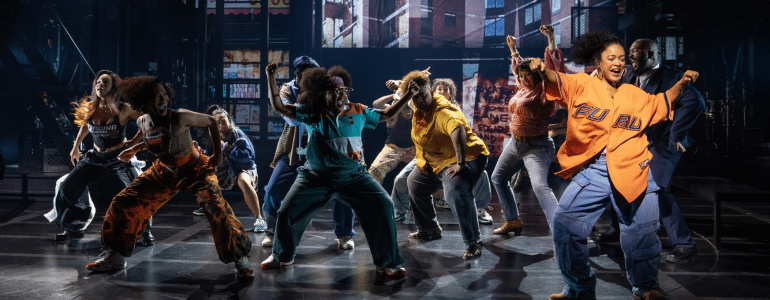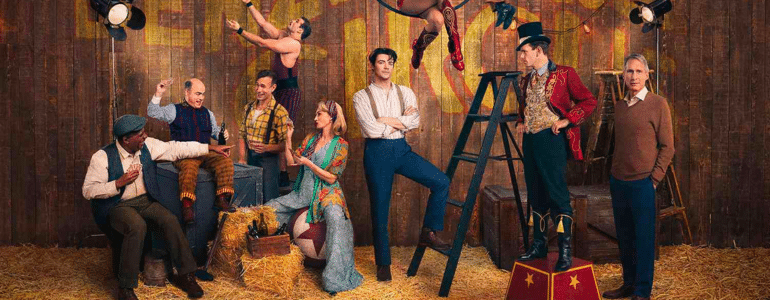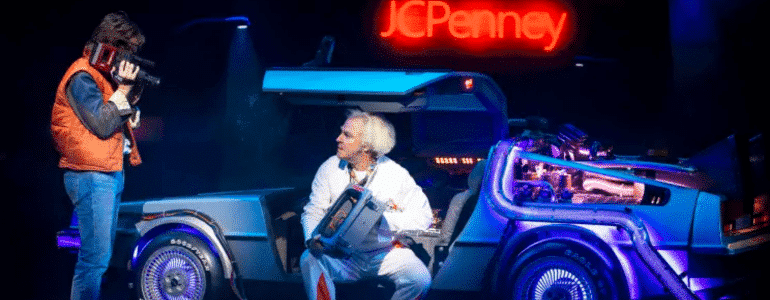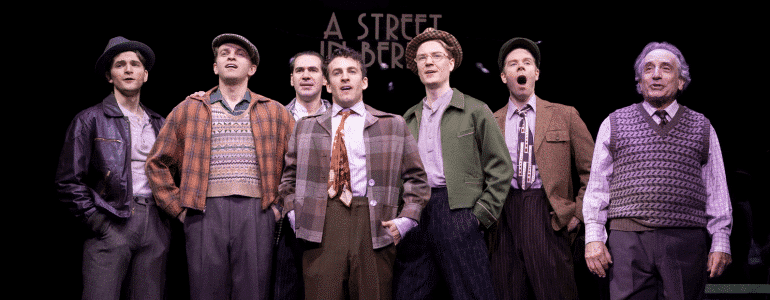Transcript – How to Make Broadway More Accessible: Panel on Accessibility
Ken Davenport: Now as I mentioned earlier, part of the reason I’ve become so passionate about this issue is because producing Spring Awakening was like getting dunked in the accessibility pool for me. I was immediately immersed into this community. Hearing their stories, their concerns, their passion firsthand was an incredible catalyst of change for me, for my staff and for anyone that’s been fortunate enough to work with them. That’s why when designing the event today I wanted to make sure you had a chance to hear from representatives from the many different communities in the world of accessibility. And so I’m happy to introduce our distinguished panelists today. In no particular order, please welcome to the stage Victor Calise, yes, as in Game of Thrones “Khaleesi,” as he just explained to me backstage. Victor is the Commissioner from the Mayor’s Office for People with Disabilities. Lisa Goring, Executive Vice President at Autism Speaks. David “DJ” Kurs, the Artistic Director of Deaf West Theatre, and Annie Leist, Special Projects Lead from Art Beyond Sight. And last but not least, the woman who leads the charge for accessibility in our industry, the moderator of our panel, Ms. Victoria Bailey, the Executive Director of TDF.
Victoria Bailey: Thank you, Ken. It’s great to be here. I think we’ve all just had the bar set very high for us in terms of this conversation. Thank you, Tim. I think we’re now going to move from the qualitative and aspirational conversation to a somewhat more practical conversation. And really, the point of this panel is for me to talk with my colleagues and friends here who have so generously agreed to share some insights with us. We’re going to talk for a little under half an hour. That’s the time we have allotted to us. The panelists have all agreed to stay after and will be available for questions after the program itself is over in the back of the theater. To get started, I thought I might ask each of you to talk a little bit about what it is you love about the theater or about the arts, because obviously that’s part of what brings you here. So I don’t know who wants to go first, but I’ll hand it off to one of you to talk a little bit about that. So why theater, why the arts?
Annie Leist: Hi, everybody. It’s such a privilege to be here. I’m so excited to be in this amazing company. My name is Annie Leist and I’m from an organization called Art Beyond Sight that I have worked at about two or three years at this point. We’re an organization that’s been around for nearly 30 years. But before I got involved in the field of cultural accessibility, which is basically this idea of making the arts and culture more accessible for people of all abilities, I was an artist myself. I still am. I’m also, for longer than I’ve been an artist, I have been a member of the blind and low vision communities. I am legally blind. I have no vision in my right eye and very limited vision in my left. But I’ve always been a visual artist myself. I’m a painter. I’ve also for a long time been a huge fan of the theater. I studied abroad for a year in London when I was in college and I was required to take a class called “The Theater and London.”
Victoria Bailey: Hardly a requirement . . . (Laughter)
Annie Leist: We were required or forced to go to the theater once a week. (Laughter) I had a couple of other friends who were just as taken by it as I was. I probably went to the theater an average of two or three times a week in that semester. It was amazing and I was in such withdrawal when I came back to my home town in North Carolina, and the West End was not there. Now that I live in New York I try to go as often as I can. I think actually one of the things I love about the theater, I think this is probably from my background as an artist, I’m particularly fascinated with how the environments, the worlds of the productions that are on stage can be so convincingly created by the set designs, and in particular the lighting designers. I think in a parallel universe I’m a lighting designer.
Lisa Goring: I’m Lisa Goring, from Autism Speaks. Professionally we hear from so many of our families how important theater is as an experience, for the entire family to do that together. But then also how those with autism really connect to the characters. It’s been terrific where we have been able to work to make sure that theater is accessible to people with autism and their families. Personally I’m the parent of a 19 year old young man with autism who absolutely loves the theater. I was just saying all he wants for Christmas or his birthday are theater tickets.
Victoria Bailey: We’re all for that.
Lisa Goring: Yes. So personally and professionally it’s very important.
Victor Calise: Hi. I’m Victor Calise, Commissioner of Mayor’s Office for People with Disabilities. I’m really happy to be here to make my Broadway debut. It is pretty cool looking out at all of you. I remember when I first came to Broadway, when I first got injured back in 1994 and I came to Broadway because tickets back then were like $7 and I was able to take my date for like $14. How great is that? But what I really loved about it is how the theater comes alive, how you’re able to experience it and see all these beautiful things happening right in front of you. I now have an 11 year old daughter who aspires to be on the stage one day. I’ve taken her to lots of Broadway plays. Not this one, not yet. It’s going to take a while. Hopefully it runs this long. But it really is great to be here. I want to thank Ken for putting this together. And I want to thank you, each and every one of you for taking an interest in this. Some of you may take an interest because it’s part of your job, and at some point in your life disability will affect you. It’s just a matter of when. Just think of this as building for your future. Thank you.
David J. Kurs: Hello. I’m DJ Kurs from Deaf West Theatre in Los Angeles. I hope some of you have seen Spring Awakening. (Applause) Thank you, thank you. I was lucky enough to grow up in southern California where there is Deaf West Theatre in close proximity to my home, and I grew up with an appreciation for theater. There’s nowhere else that exemplifies that like New York. People here love and understand theater as I do. Deaf West is one of the few producing sign language theaters to this day in the country. We were very excited to bring theater to young audiences to more deaf people because we think that’s where appreciation of the arts begins, with younger people, and because of my own story. It’s been one of the great pleasures of my career to be here in New York and have deaf people flying in from all over the country, to celebrate with old friends from other parts of the country to see this performance on Broadway together. It was a first Broadway production for many of them to see, or to see a professionally produced piece of theater. And that is really inspiring for me as an Artistic Director.
Victoria Bailey: Thank you very much. One of the things that I was thinking about as we got ready for this panel was to ask you a little bit to share some of your experiences about bright spots in accessibility as you’ve experienced them. I think we just heard from David about a real bright spot for this show, which has been very, very special, and for all the people who have come to see it. But thinking in your own personal experiences, or folks you’ve heard from or may have heard from through your work, what are some bright spots that exist out there now? Both here and we have folks from not only New York but from venues around the country, so we don’t have to limit it just to a conversation about here. Anyone want to go with that?
Lisa Goring: I can start. Theatre Development Fund has actually done . . .
Victoria Bailey: This is not a plug, by the way. (Laughter)
Lisa Goring: No. But it has been absolutely terrific. There have been several autism-friendly performances both in New York and Boston. I know our chapter in Boston had worked with them. Both of those performances sold out very, very quickly. Our families are so thankful for the opportunity to be able to come and experience a Broadway show. The other piece is that for some, it can be the only way they see theater, for others it’s a stepping stone and they feel more comfortable once they’ve done that, to be able to then really think about all the theater has to offer and do shows that are maybe not just autism-friendly. It really has been a tremendous, tremendous benefit to many of our families.
Victor Calise: I have to say one of the most recent ones is seeing this play. Spring Awakening has put something together that is extraordinary. The way theater should be for everybody. It’s so inclusive. From the actors . . . the first person in a wheelchair on Broadway. Can you believe it’s taken this long for it to happen? (Applause) It’s insane. The Americans with Disabilities Act has been around for 25 years and we finally got to that. Seeing the way the spoken word is so intertwined with the written word and sign language. It’s really what and how theater should be every day. And definitely TDF. TDF has been on this forefront for so long. I reached out to them, within the last three or four years, and how do we make theater more accessible? And they were doing it, and they’ve been doing it for so long. The League has been behind them, Charlotte has been behind them and pushing this. But TDF, I want to thank you for continuing to do that.
Victoria Bailey: Thank you. This is not about TDF.
Victor Calise: I know it’s not. But it’s a bright spot.
Victoria Bailey: I think something important to understand . . . and then I want to hear from the other two . . . is it helps that we are an organization whose mission is about making sure that people can get to the theater. If you have that in front, I think that probably made it easier at the beginning for us to look at programs that would help do that. So it kind of was in our consciousness sooner, but it’s been part of what we’ve done for a long time. Annie?
Annie Leist: I have a couple of very quick points. First of all, I have to confess I’ve never been to one of the TDF-sponsored described programs.
Victoria Bailey: That’s okay.
Annie Leist: But they’re really amazing. Description is something that can be done at many performances where someone who is blind wears a headset and there is a person who is describing the nonverbal action that’s happening on stage, and the costumes and the lighting and all the amazing things that are part of this environmental experience. Because I haven’t been to one, I sought out some testimonials from colleagues of mine who do theater description. The continuous thing that I kept seeing that was a thread through all of them was people saying, “I never thought I would enjoy the theater again after I lost my vision.” Or “I didn’t really think I could follow what was happening on stage.” Or after going to an audio described performance, “I didn’t realize how much I had been missing and how important these details were.” And most importantly, “Now I’m tempted to go to things I might not have gone to before when I know that there’s going to be something there for me that will help me.” That’s one point, broadening the audience. Another point is, for me personally, when my 13 year old niece came to New York and we took her to see Wicked, we also took her to a behind the scenes tour that is offered. It’s not something that is designed for accessibility audiences specifically or people with disabilities. But I can tell you it was really useful for me to understand how things were arranged on stage and to be prepared ahead of time to sort of get it. I knew where to look and where to pay attention a little bit better. I got the story so much better than I think I would have if I had not participated in that tour. So things that are not necessarily designed for people with disabilities actually can benefit everyone.
Victoria Bailey: David, this is kind of a curve ball in this question for you, as I thought maybe it’s not fair to talk to you about the theater because it’s where you make your living, but maybe to talk a little bit, if you would, because I’ve head you talk on other occasions, about what it’s been like to create careers for some people who might not otherwise have thought they could have a career in theater as a different kind of bright spot.
David J. Kurs: From a different perspective, I can say I appreciate making art accessible to the deaf community, and to other disabilities as well. From an audience perspective, we mentioned previously this is some people’s first time to see a Broadway or professional show, they come from different cities. Regional theaters across the country, they provide interpreting or captioning. There is a range of sophistication in the theater world and accessibility, of course. We’d like to have all those discussions. For us in the deaf community, we have many great artists, dancers, choreographers, all kinds of artists. We have a great creative talent group. And a big part of our mission is to give those artists accessibility to work, and to make them successful on their own terms and to increase accessibility for them. I only wish there were more opportunities for various artists with different disabilities.
Victoria Bailey: Thank you. We talked about bright spots. I think now I’d like to turn to a conversation to hear some suggestions, really practical . . . people who know me know that I’m kind of known for being very practical. I’m interested in . . . we all know the big stuff. We know the things that we need to be doing globally. We know the things we need to be investing in. But what are some practical things that you would like – some of which people may already be doing – but things that occur to you that theaters and performing arts venues could be doing that aren’t so complicated. They almost might go into the category of “Duh,” but what are things you’d like to share as things folks could be thinking about doing to make it easier for people to go to the theater?
Victor Calise: I think it’s important that you hire someone with a disability. The idea of having someone with a disability on your staff. Why? Because they’re going to see things you don’t. It’s going to build acceptance and tolerance in your work place. You’re just going to get accessibility. I’m going to ask a question. How many people out there have people with disabilities that they employ in their offices? All right. Here is another question. How many people out there have people that wear glasses that work with them? A lot more hands go up. I want to see more hands next time I ask that question. It’s important. If we hire people with disabilities, it changes the perception of everything that we do. And another note is that there are close to one million people with disabilities here in New York City. You know what a revenue stream that is? That’s just not talking about the 54 million people that visit New York City every year, we take a guesstimate that about 10% are people with disabilities. You’ve got five million people with disabilities visiting the city a year. Billion dollar industry. I makes sense to make your things accessible. And more importantly, hire people with disabilities on your staff.
Victoria Bailey: Other practical suggestions? Annie, you have a list. She told me that ahead of time.
Annie Leist: I promise I’ll be brief. We could all go on about these sorts of things forever, which is why I’m really excited that we’re going to have opportunities to talk with you guys more informally afterwards. But one of the things I want to get people thinking about is that accessibility doesn’t start when someone arrives at the theater. It actually starts beforehand. Someone tries to find out about the event or the production, when someone goes to the website, it’s really important to make sure that you are making your production welcoming before someone even gets to it or decides to attend it. Things like making your website accessible for people who use screen readers to navigate the computers and phones with their ears rather than their eyes. Making ticketing accessible for people with all abilities. Having lots of different options for getting ticketing, not just a phone number or an online ordering opportunity or an in person ordering opportunity. Describing the images on your website. Making sure you have really great directions to your institution, or to your venue. Also talking about what will be there when the person gets there. Things like making it really clear that there are special seats available for people in wheelchairs, making it really clear about when there will be captioned or sign interpreted or described shows, making sure you get the word out. Because if you do all of this amazing stuff that you don’t connect with the audience and the audience doesn’t know that they will be welcomed, then you will be missing out on all those people that Victor has been talking about.
Lisa Goring: I would agree with everything that Annie says, as well as Victor. Because certainly employment is a key piece for everyone. But the idea that knowing ahead of time what’s going to happen is really important. Knowing that there’s a space that they could go to if they need a break is really important. Knowing a little bit more about the show. For a lot of people with autism, if they know ahead of time what’s going to happen, what the story is about, they really enjoy it that much more. So those are things that certainly help people with autism, but really I think would help everyone. That really has been an important piece for certainly the autism community.
David J. Kurs: For me, it’s important to view accessibility as a long term process. It’s not something we’re going to achieve. We’re not finished doing it and we’re going to have to keep doing it. You can’t think, “I’ve done the general provision they told me I’m to do, and I’m good, right?” No. We have to keep providing a new bar and setting it higher and higher.
Victor Calise: Make it part of your culture. Who you are, what you do, how you approach it. If you’re not disabled, think about that person in your situation. Be able to billed for that capacity. Think about seating within your theater and making sure seating is accessible not just in the back but in the front as well, or on the side or on a different level. Think about those things and make them part of your culture.
Annie Leist: I think it doesn’t have to be complicated or expensive. It’s wonderful to be able to do descriptions, to be able to do captioning, to be able to do programming that is for a targeted audience or people with a particular disability. But even something as simple as what was done today when you came in. You were offered two different types of programs. One that was regular print and one that was larger print. That was actually a really quick, easy, relatively inexpensive thing to do. Or make the program available ahead of time on the website in a digital format so people can connect with it and get the information from it in a way that’s best for them. It doesn’t have to be complicated. And also a lot of it has to do with customer service. Expanding the culture of inclusion and welcoming to make sure that the venue that your production is at trains their front line staff, and basically awareness, diversity, and tolerance and trying to get to yes with all the productions. A lot of it is great customer service which again benefits everybody.
Victoria Bailey: I think something Victor said that’s really important not only about who you hire but certainly at TDF for instance, when we started the autism initiative, Lisa Carling, who is here and who is the director of our access program, she knew we couldn’t do this on our own. We reached out to experts in the field, we reached out to Lisa. We didn’t know about what was required to provide an autism-friendly performance. What we knew was it was something we should do. We also didn’t assume we finished learning the first time. The first performance, our list of things we’d do differently the next time was longer than our list of things we were glad we’d done right the first time. A really simple example was we didn’t really think about the fact that we were going to need family rest rooms, that we were going to need more than one family restroom. Those were the kind of really simple things. I don’t think we would have . . . we can’t do this alone. We do this because we had other people helping us. You have to keep learning. Like David says, you’re never done. And also it’s talk to the people who need the service. My father had Parkinson’s, and by the end of the time when he was able to be out and about . . . my parents loved to go to the theater. So they came to New York. I got them house seats for History Boys. Mom said, “What seats?” I said, “I got house seats.” She said, “Those are going to be in the first ten rows, I can’t do that. We need to be in the back row because the least distance your father has to travel is the most important.” He needed to come in, sit down, and get out. To me it was a lesson of you have to actually talk to people and say, “What do you need, what do you want?” as opposed to second guessing. I thought it was an aisle seat, as opposed to the last row of the theater.
Victor Calise: I think it’s important to absolutely understand and realize that there are lots of nonprofit organizations out there willing to help for free. And they’re there. I know the Mayor’s office would love to come back and give everybody training on disability etiquette. We do that, Mark on my staff is over there smiling right now thinking, “Yeah, let’s get this done.” It’s free.
Lisa Goring: Absolutely. We’d love to do things like that.
Annie Leist: Us as well.
Victoria Bailey: We can fly David in any time, but who’s going to leave California in the winter? (Laughter)
David J. Kurs: If I could just say, it’s exciting to me that we have had many firsts on Broadway. The first person in a wheelchair, also the first deaf-blind interpreted performance here on Broadway. I don’t know I’ve gotten all the firsts, but even though we’ve achieved those things I still feel like there’s so much more to do. So much more. I think that as we learn from each other, and make those kinds of conversations as we go along, that it’s important that we have to capitalize on the relationship we’re building and keep the accessibility revolving.
Victoria Bailey: I think that’s important. As a last question, let’s move beyond our field and look outside the theater. Dangerous as that may be, let’s look outside the theater. Can you just think what are some industries, who are some folks who are doing it even better than we are? Where are places we should look? Where might you point us for some tips on how to do it better or more quickly? Who is doing really good stuff outside the theater?
Annie Leist: I can jump in with that. One of the fields that Art Beyond Sight works a lot with is the museum and cultural institution community. We’re very fortunate to live in New York where museums like the Metropolitan Museum and the Museum of Modern Art and others have been welcoming people with disabilities for years and years. So it’s very interesting to sort of see what different levels of accessibility and inclusion are being focused on. Two things about that. One thing that’s really interesting about the museum community is that they have banded together to share resources and share information. There are two different organizations off the top of my head in New York that I can think of where people working in accessibility either in the education or visitor services portion of the museum come together to meet regularly and connect with each other, and learn from each other and share information. There’s also conferences out there. One that jumps to mind is the Leadership Exchange in Arts and Disability that’s hosted by the Kennedy Center every year in August. They have tracks that are specifically about performing arts venues and theatrical productions. They also bring in museums and arts organizations and other areas of art and culture. It’s been going for 15 years and it’s a wonderful resource.
Lisa Goring: Those are terrific resources for everyone. Just some other resources: airlines. We’ve found that we’ve been able to work with airlines to welcome families. We train up front the airline staff, airport staff, TSA, and then they invite families to actually go through the whole process. So before they buy the ticket for a plane, they can go to Kennedy Airport, check in, go to the gate, go through TSA, get on the plane, and the plane goes around the tarmac and then they get off.
Victoria Bailey: Do all airlines do that?
Lisa Goring: No, we actually partnered with JetBlue.
Victor Calise: JetBlue, the gold standard.
Lisa Goring: And all of their staff volunteers. They are not paid for that time. They all volunteer. They’ve actually had other airline staff come to volunteer with them so they can learn about people with disabilities and also the people with disabilities can learn about how to use air travel. That’s been one. And we’ve also . . . Major League Baseball has done a really nice job of learning about disabilities, and what they can do to be more welcoming. Whether it’s lowering the sound a little bit in certain sections, having certain sections that are a little bit more friendly to a certain disability, and even vendors and the food court people to be able to train them so they’re more welcoming as well.
Victor Calise: Certainly JetBlue, we work with them. All the cultural institutions, Mayor’s Office for People with Disabilities is constantly figuring out ways to work with them through their design and construction programs and services. The New York Yankees do a great job, an excellent job in the city. Madison Square Garden. The Yankees really do go above and beyond. You can look there. One place that actually . . . it’s a shameless plug. I’ve been working with them for a while. Every March there is the ReelAbilities Film Festival. Go check it out, it’s theaters throughout the city. ReelAbilities. It’s just great. Audio description, captioning, films by people with disabilities. Go check it out. You’re going to see something happening in March. There will be ads throughout taxicabs. It is certainly a great thing to check out.
David J. Kurs: Movie theaters. You would think that they would be more enlightened . . . the film industry, they’re doing a better job with accessibility than many productions are. They have various kinds of captioning available, rear view captioning, goggle captioning. Broadway has a lot to do to catch up to the film industry.
Victoria Bailey: I would guess that when you fly, you’re more likely to fly JetBlue, Lisa. I would guess you go to the Yankees more than you might go for other reasons as well. (Laughter)
Victor Calise: Full disclosure, I’m a Mets fan.
Victoria Bailey: Which is only to make the point that is really important, which is on top of everything else, not only is being as welcoming to as large a group of people as possible the right thing to do, it makes some good business sense. We’re up to four autism-friendly performances a year. They’ll sell out every time.
Victor Calise: I’ll just throw out a couple of numbers. There’s close to one million people with disabilities. And they have friends, families, brothers, sisters, mothers, fathers, that will follow them to these areas.
Victoria Bailey: Let’s face it, to some extent we’ve been hindered in the theater. It’s one of the reasons maybe films are made a little different. I think we miss the part that says people go out. People are going to go out. People want to do things. People with disabilities are going to go out just like anyone else. That’s the part that I think is slowly getting traction. I think that’s the point of a conversation like this. “Okay, how do we make people feel more welcome?” I think we’re at time. Victor, if there’s a closing comment any of you want to make, please do. Otherwise, I think we have a treat ahead of us.
Victor Calise: Just get it done. People with disabilities want to be part of society. We are part of society. Just make it more desirable for us to come out and see everything that you have to offer. We’re working to make New York City the most accessible city in the world and we need your help. (Applause)
David J. Kurs: Thank you, Victor. But we need you to work with us. Thank you for being here. We appreciate you collaborating. We appreciate Ken Davenport, everyone here making this a success every step along the way. It’s a team effort, it truly is.
Victoria Bailey: I want to thank our panelists. I also have been able to hear some kind words about TDF. I want to acknowledge some members of the TDF team who are here. Lisa Carling, who runs our access program. Christina Trivigno, who’s here and has been a major part of something you’re going to hear about it in a minute. It’s not just me. And I was really struck . . . through this conversation we’ve been talking both about the power of seeing and experiencing stories from folks with disabilities from the stage, and from the audience. This is a two way experience. I think it’s really important, and I’m really glad that we’ve focused on both sides of the equation, both on stage and in the audience. Thank you very much for being here and for listening. (Applause)
Podcasting
Ken created one of the first Broadway podcasts, recording over 250 episodes over 7 years. It features interviews with A-listers in the theater about how they “made it”, including 2 Pulitzer Prize Winners, 7 Academy Award Winners and 76 Tony Award winners. Notable guests include Pasek & Paul, Kenny Leon, Lynn Ahrens and more.













